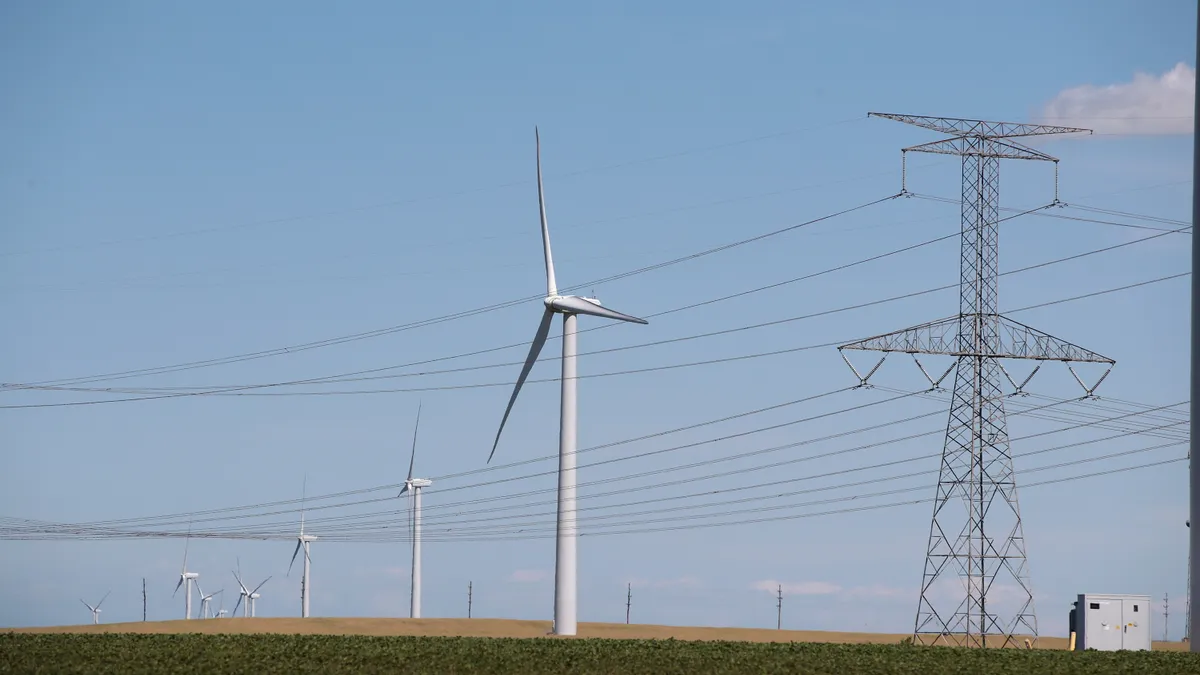Dive Brief:
- PacifiCorp on Wednesday filed the latest iteration of its long-term integrated resource plan (IRP) with the regulatory commissions of the six states in which it operates, outlining a series of investments in renewables, battery and pumped hydro storage, advanced nuclear and energy efficiency programs.
- The utility estimates that its 2021 plan will lead to a 74% decrease in greenhouse gas emissions from 2005 levels by the end of this decade, a more aggressive trajectory than the original 59% reduction it envisioned in its 2019 IRP.
- However, the utility's decision to retain some coal and gas generation in its portfolio into the 2040s drew criticism from conservation groups. The Western Resource Advocates (WRA), Sierra Club and others said in a statement that decarbonizing the electric sector within the next 15 years is critical to reaching net-zero economy-wide emissions by 2050.
Dive Insight:
PacifiCorp's 2021 IRP details thousands of megawatts of new resources across its 20-year planning horizon, including 3,628 MW of new wind and 5,628 MW of new solar, a lot of which will be paired with storage.
The plan "is designed to determine the lowest-cost options for customers, adjusting for risks, future customer needs, system reliability, market projections, and changing technology," Rick Link, PacifiCorp's vice president of resource planning and acquisitions, said in a statement.
"We depend a great deal on public involvement by utility regulators, customers and other stakeholder groups to develop this plan," Link added.
The plan outlines a preferred portfolio across the six states that would add 1,302 MW of new solar by the end of 2024 and 1,902 MW by the end of 2026. In addition, it includes nearly 1,800 MW of new wind generation by the end of 2024. On the storage front, the utility expects that by 2040 it will have 4,781 MW of storage co-located with solar systems, 1,400 MW of standalone battery storage and 500 MW of pumped hydro.
PacifiCorp, for the first time, also included non-emitting peaking resources and new advanced nuclear in its preferred portfolio. Non-emitting peaking resources are essentially resources that are designed to be dispatched only when needed to meet shortfalls that will use non-emitting fuels like hydrogen. The plan includes a 500 MW advanced nuclear demonstration project scheduled to come online in 2028 as well as 1,226 MW of non-emitting peaking resources through 2040.
All these investments are good news, Sophie Hayes, senior staff attorney with WRA said.
"The bad news is that they do intend to maintain significant amounts of their fossil fuel generation capacity," including coal-fired power plants, she said. "These plants are a major source of both high emissions and costs for PacifiCorp's ratepayers."
PacifiCorp's preferred portfolio would retire 14 of its 22 coal units by 2030, and 19 by 2040, in part because of the costs of these facilities as well as the decreasing costs of competing resources. The utility anticipates that these retirements as well as gas peaker conversions will reduce its coal-fired generation capacity by 2,200 MW by 2030 and more than 4 GW by 2040. It is also looking at retiring 1,554 MW of natural gas capacity by 2040.
But conservation groups say that this plan doesn't go far enough. The groups are pushing for an 80% reduction in power sector emissions by 2030, and net-zero by 2035. If the coal remains on the system and is run at high capacity factors, they could produce significantly more emissions than the utility has projected, Hayes said.
"Customers, not PacifiCorp, bear all the risk of increasing coal fuel prices and costs associated with potential environmental regulations and so because of this, the utility lacks an incentive to reduce operations at the coal plants," she added.
Modest gains in near-term clean energy commitments along with maintaining coal burning capacity into 2040 and beyond "doesn't cut it," Lindsay Beebe, a senior campaign representative with Sierra Club's Beyond Coal campaign, said in a statement.
"As a monopoly corporation that has been using millions of publicly furnished dollars to fight pollution controls on their coal plants, ignore climate change science, and waste years of precious time with inaction, they don't get a gold star for doing the bare minimum," Beebe added.
In response to these concerns, PacifiCorp spokesperson David Eskelsen referred back to the company's estimates that its plan will reduce emissions 74% by 2030. Continued clean energy acquisitions, as well as transmission investments outlined in the plan, will result in a 98% reduction of greenhouse gas emissions by the middle of the century, according to the utility.
"[T]his course of action represents the least-cost, least-risk options for our customers," Eskelsen said in an email.















